

| Catalina & Isa Quintanar | Spring, 2006 |
| U.S. History 1302 | R. Hines, Instructor |
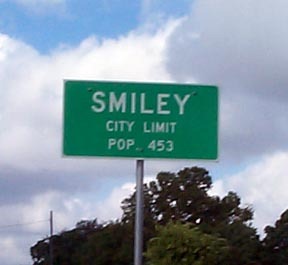
 Smiley Texas was originally known as Smiley Lake. This small town of 453 in population lies in Gonzalez County in between Nixon and Cuero, Texas. Originally this town received from a young named Jim Smiley. He was a sheepherder. He came to the south Texas area around the mid-1850ís. In addition, sheep and horse raisers were also drawn to the lake. Smiley Lake is considered to be the largest body of water between the San Antonio River and the Guadalupe River.
During the Civil War there were losses, horses were being sold to neighboring southern states to replace the hole in the economy that the Civil War left. Furthermore, pistol-packing drivers were necessary to due to being paid in gold. Smiley Lake was also used for the Chisholm Trail to Kansas, a holding area for the cattle bound for Eastern markets.
Back in the early 1870ís, many settlers were starting to move into the area. Then soon enough there was a trading center established at Smiley Lake. In the year of 1867, Mr. Major Phillips moved his store from the location Coon Hollow, which was located on the Cuero-Rancho road to the bank of the lake. In 1872, the first United States Post office was established by D.M. Livingston, who became the first postmaster.
A native from Georgia named George Colley built the first gin and grist mill im 1879. This mill was known to be the first in Gonzales County. In 1882, Colley helped found the First Baptist church.
A few years later Smiley became the ultimate trade center, and boasted a general a general store with farm implements, and with three dry-good stores, two drug stores, a saddle and harness shop, a blacksmith shop, a cotton seed oil mill, a millinery store, a school building , a I.O.O.F lodge and a weekly newspaper. This small town also had three doctors that lived there who served a large territory
The town moved to its present location(less than a mile north) in 1906 when the Galveston, Harrisburg, and San Antonio railroad arrived. Intensive cotton farming had depleted the soil by depression time when Lloyd Bell installed the first chick hatchery.
By the late 1970ís and 1980ís other changes became obvious. Housing had increased by a great percentage than in any other town in Gonzales County. Quite a few oil and gas wells had been drilled in the Smiley area and were producing.
Smiley Texas was originally known as Smiley Lake. This small town of 453 in population lies in Gonzalez County in between Nixon and Cuero, Texas. Originally this town received from a young named Jim Smiley. He was a sheepherder. He came to the south Texas area around the mid-1850ís. In addition, sheep and horse raisers were also drawn to the lake. Smiley Lake is considered to be the largest body of water between the San Antonio River and the Guadalupe River.
During the Civil War there were losses, horses were being sold to neighboring southern states to replace the hole in the economy that the Civil War left. Furthermore, pistol-packing drivers were necessary to due to being paid in gold. Smiley Lake was also used for the Chisholm Trail to Kansas, a holding area for the cattle bound for Eastern markets.
Back in the early 1870ís, many settlers were starting to move into the area. Then soon enough there was a trading center established at Smiley Lake. In the year of 1867, Mr. Major Phillips moved his store from the location Coon Hollow, which was located on the Cuero-Rancho road to the bank of the lake. In 1872, the first United States Post office was established by D.M. Livingston, who became the first postmaster.
A native from Georgia named George Colley built the first gin and grist mill im 1879. This mill was known to be the first in Gonzales County. In 1882, Colley helped found the First Baptist church.
A few years later Smiley became the ultimate trade center, and boasted a general a general store with farm implements, and with three dry-good stores, two drug stores, a saddle and harness shop, a blacksmith shop, a cotton seed oil mill, a millinery store, a school building , a I.O.O.F lodge and a weekly newspaper. This small town also had three doctors that lived there who served a large territory
The town moved to its present location(less than a mile north) in 1906 when the Galveston, Harrisburg, and San Antonio railroad arrived. Intensive cotton farming had depleted the soil by depression time when Lloyd Bell installed the first chick hatchery.
By the late 1970ís and 1980ís other changes became obvious. Housing had increased by a great percentage than in any other town in Gonzales County. Quite a few oil and gas wells had been drilled in the Smiley area and were producing.A Historical Landmark Says:
Attracted by abundant water from a natural lake,
settlers began moving to the area in the late 1840s.
Ranching provided the earliest commerce. In addition
to cattle and sheep, ranchers raised racing horses for
sale in the southern states. Cattlemen brought their
herds to the lake area until they were ready for
transfer to Belmont (20 miles north), where a branch
of the Chisholm Cattle Trail was located. George W. Colley, considered to be the founder of
Smiley Lake Community, moved here in 1870. Near his
home he built a steam-powered cotton gin and sawmill.
He was joined later by Major W. M. Phillips who
opened a mercantile establishment here in 1883. The
settlement of Smiley Lake, named for early pioneer
Jim Smiley, was located on the Cuero-Rancho trade
route between San Antonio and the Gulf port of
Indianola. The village once had a saddle factory, blacksmith
shop, wire fence plant, newspaper, general stores,
drugstore, school, Baptist church, an I.O.O.F. Lodge and a
Post Office established in 1884. When the Galveston,
Harrisburg & San Antonio Railroad completed lines
nearby in 1906, the Town of Smiley was moved to the
present location (one mile north).
Images of Smiley, Texas and their meaning:
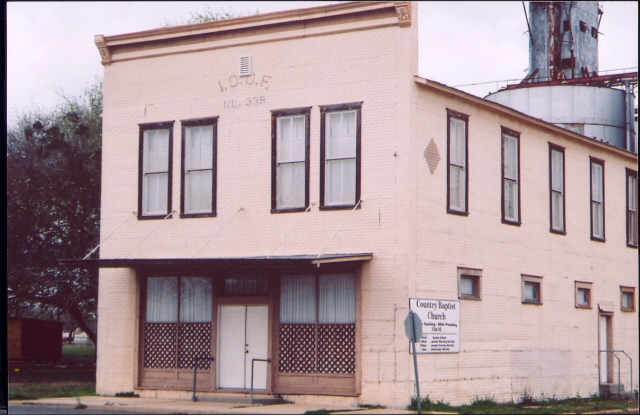
This here is the old L.O.O.F Hall. This building is now being used for a church. Smiley has silos and barns which have been standing for many years. Most commonly silos are used in agriculture to hold grain or fermented feed known as silage.
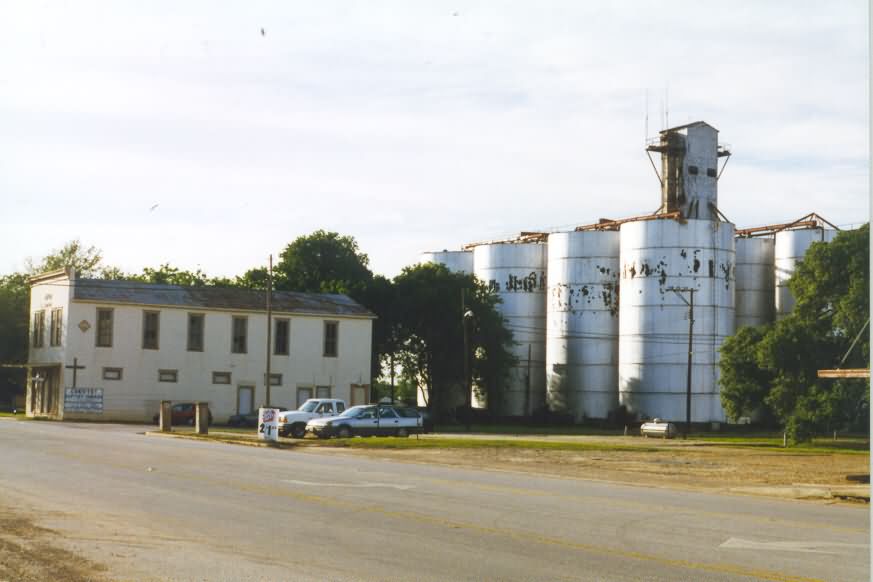

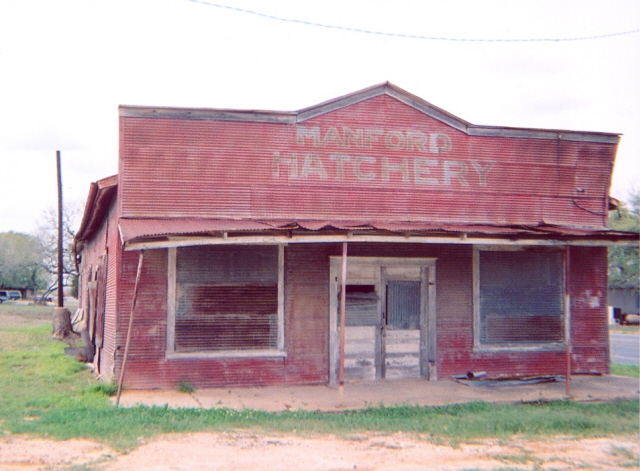

This building is The Grange Hall in Smiley Texas. This organization provides many benefits for its members. This here is the Local Smiley Library. It was donated by Mrs. Stella Ellis Hart. This library is known as, "The Stella Ellis Library." This town may not have a museum, but it sure it does have many things to show. This very unique town can surely show it's historical background with it's neat library. Here is Smiley's City Hall. Though it may be small it is sure ran by a great staff. And one of those staff members of Smiley City Hall is Mrs. Eloise Estes.
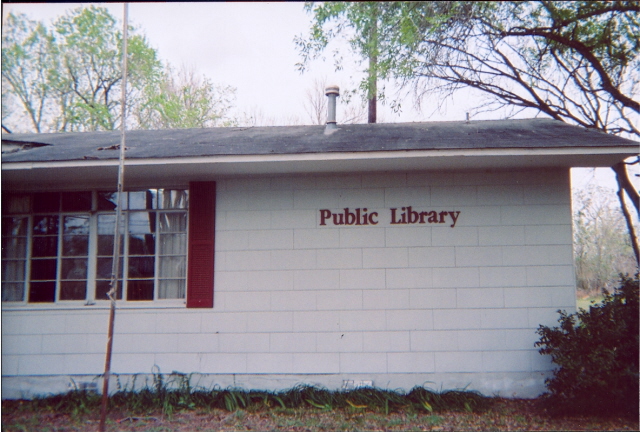

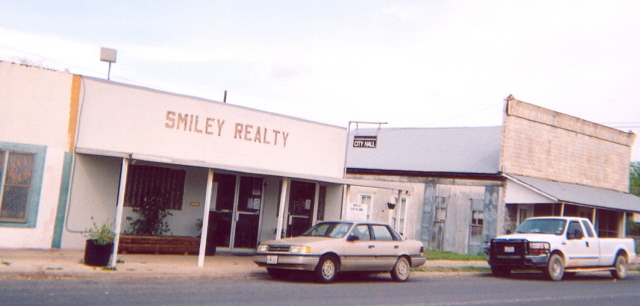

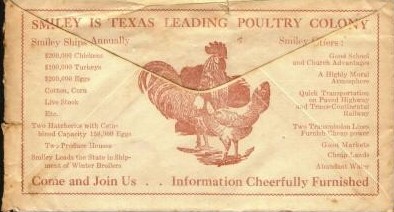
Here is a picture from a U.S Postal Cover from the U.S. Postal service in Smiley. The post office opened in the year 1884, and became number three in the county of Gonzales. This was Smiley's principle drug store. The men are; standing at far left behind the counter is
Winchester "Chess" Sample, man sitting to the left of the group at the table is Dr. Henry Hatch Beverly.(Photo courtesy of Rob Schmidt.)
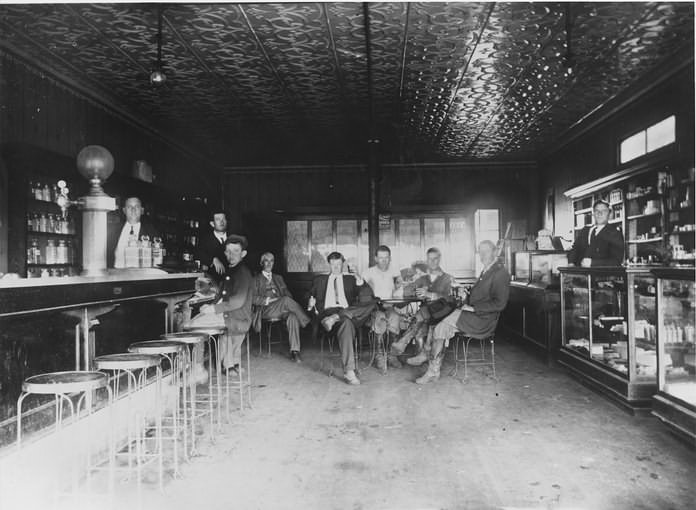
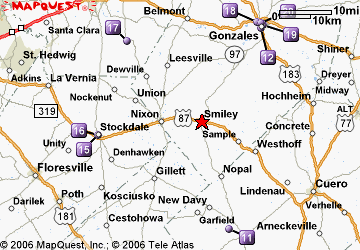
City Map
ANNOTATED BIBLIOGRAPHY:
www.tsha.utexas.edu/handbook/online/articles/GG/hcg7.html" Gonzalez County. This website helped find the information needed for Gonzales County.
www.wilcoxen.com/family: From "An American Family" Tribute Page; Smiley Texas, home of the Bantams.
www.nixontx.com: This website helped recieve information on Nixon Texas.
www.www.pvahec.org/cuero.html: This website also helped us to find out what Cuero, Texas was about.
www.ok-history.mus.ok.us/enc/chsmtrl.htm" Chisholm Trail; this webpage was help on finding out what the Chisholm Trail was.
www.mainstreet-marketplace.com/Pages/Misc/Odd%20Fellows.htm" I.O.O.F, this webpage was of great help to find out what the Internationl Order of Odd Fellows is about.
www.grange.org: Information on the Grange Hall is found on this website.
www.maps-n-stats.com/us_tx/us_tx_smiley_m.html Directions to Smiley Texas.